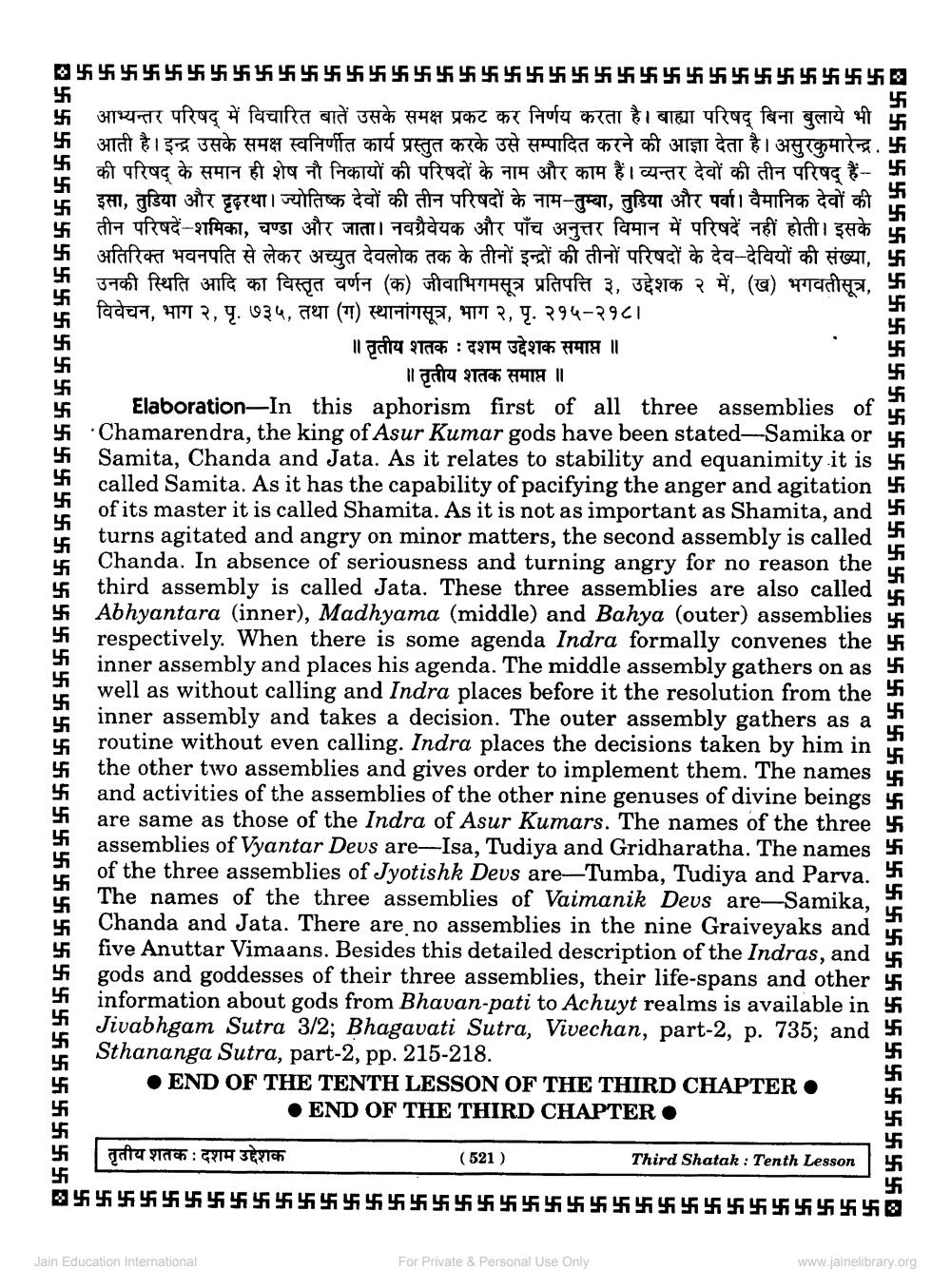________________
卐 卐 + है
卐
55555555555555555555555))))))))))))))))))))))
आभ्यन्तर परिषद् में विचारित बातें उसके समक्ष प्रकट कर निर्णय करता है। बाह्या परिषद् बिना बुलाये भी आती है। इन्द्र उसके समक्ष स्वनिर्णीत कार्य प्रस्तुत करके उसे सम्पादित करने की आज्ञा देता है। असुरकुमारेन्द्र. की परिषद् के समान ही शेष नौ निकायों की परिषदों के नाम और काम हैं। व्यन्तर देवों की तीन परिषद् हैं-5 इसा, तुडिया और दृढ़रथा। ज्योतिष्क देवों की तीन परिषदों के नाम-तुम्बा, तुडिया और पर्वा। वैमानिक देवों की तीन परिषदें-शमिका, चण्डा और जाता। नवग्रैवेयक और पाँच अनुत्तर विमान में परिषदें नहीं होती। इसके अतिरिक्त भवनपति से लेकर अच्युत देवलोक तक के तीनों इन्द्रों की तीनों परिषदों के देव-देवियों की संख्या, उनकी स्थिति आदि का विस्तृत वर्णन (क) जीवाभिगमसूत्र प्रतिपत्ति ३, उद्देशक २ में, (ख) भगवतीसूत्र, विवेचन, भाग २, पृ. ७३५, तथा (ग) स्थानांगसूत्र, भाग २, पृ. २१५-२१८।
॥ तृतीय शतक : दशम उद्देशक समाप्त ॥
॥ तृतीय शतक समाप्त ॥ Elaboration In this aphorism first of all three assemblies of Chamarendra, the king of Asur Kumar gods have been stated-Samika or Samita, Chanda and Jata. As it relates to stability and equanimity it is 456 called Samita. As it has the capability of pacifying the anger and agitation of its master it is called Shamita. As it is not as important as Shamita, and i turns agitated and angry on minor matters, the second assembly is called Chanda. In absence of seriousness and turning angry for no reason the third assembly is called Jata. These three assemblies are also called Abhyantara (inner), Madhyama (middle) and Bahya (outer) assemblies 4 respectively. When there is some agenda Indra formally convenes the 4 inner assembly and places his agenda. The middle assembly gathers on as well as without calling and Indra places before it the resolution from the inner assembly and takes a decision. The outer assembly gathers as a routine without even calling. Indra places the decisions taken by him in the other two assemblies and gives order to implement them. The names and activities of the assemblies of the other nine genuses of divine beings y are same as those of the Indra of Asur Kumars. The names of the three assemblies of Vyantar Deus are-Isa, Tudiya and Gridharatha. The names of the three assemblies of Jyotishk Devs are-Tumba, Tudiya and Parva. The names of the three assemblies of Vaimanik Deus are—Samika, Chanda and Jata. There are no assemblies in the nine Graiveyaks and five Anuttar Vimaans. Besides this detailed description of the Indras, and gods and goddesses of their three assemblies, their life-spans and other information about gods from Bhavan-pati to Achuyt realms is available in Jivabhgam Sutra 3/2; Bhagavati Sutra, Vivechan, part-2, p. 735; and Sthananga Sutra, part-2, pp. 215-218. • END OF THE TENTH LESSON OF THE THIRD CHAPTER
• END OF THE THIRD CHAPTER •
卐)5555555555555555555555))))))
| तृतीय शतक : दशम उद्देशक
(521)
Third Shatak: Tenth Lesson
步步步步步步步步步步步步步步步牙牙牙牙牙牙牙牙牙牙牙牙牙牙步步步步步步。
Jain Education International
For Private & Personal Use Only
www.jainelibrary.org




